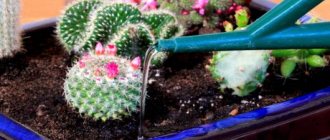Wintering cacti in nature
In the wild, cacti live in arid and heavily sunlit areas. These are the deserts of Africa, Asia, North and South America. Plants tolerate large temperature changes, which can reach 50 °C. They are able to accumulate moisture and survive in conditions of elevated ambient temperatures - up to +60°C. But the main feature of plants is their adaptability to a small amount of incoming water. The precipitation rate in deserts is most often 200-300 mm/year.
In places where cacti grow, temperature fluctuations are most often observed in winter. At night after a hot day there are frosts, because the heated soil quickly cools down.
Cacti - watering rules
There are endless varieties of cacti! Each of them deserves a separate article! Therefore, it is impossible to create an exact watering schedule, because it depends on the type, temperature, season, and substrate. However, general recommendations can be given that will be useful for growing most species of thorny fellows.
Note... Cacti are a family of perennial plants. South America is considered the homeland of these ancient inhabitants of the planet. Their distinctive feature is the spines, as part of the areola - the axillary bud on which they are located.
Caring for cacti in winter at home
These plants are unpretentious and require minimal care from the owner. However, those that are always kept in a warm room will never bloom, with the exception of certain species. High temperatures cannot compensate for the decrease in daylight hours that occurs in winter. As a result, most cacti, without wintering, do not bloom, stretch out, and lose their attractiveness. During rest, the foundation is laid for future buds and preparations for the future growing season are underway.
Winter maintenance of cacti at home comes down to gradually stopping watering and ensuring coolness.
Temperature
To organize winter hibernation, prickly plants need to create a temperature from +5 to +15 °C. This range is most suitable in dry conditions to ensure the dormancy necessary for further development and flowering of plants. At night, a drop in temperature is acceptable.
The possible temperature range varies depending on the type of cacti. Many of them can withstand short-term frosts from -2 to -4 °C. Some plant species can tolerate cold down to -35 °C. However, most of them cannot tolerate sub-zero temperatures.
It is difficult to create such conditions at home. There are several options for this. The first of them is to create a suitable microclimate on the glazed loggia. If necessary, it is insulated with polystyrene foam, cracks are sealed or windows are replaced, and plants are wrapped.
The second way to organize wintering is a mini-greenhouse made of plexiglass or film on the windowsill. To do this, a frame made of beams or thin slats is attached to wooden frames using metal corners and the cacti are protected from the warm air of the heating radiators. The necessary cold comes from the glass. You can control the temperature in such a mini-greenhouse using a thermometer. In summer, the structure is removed and the corners are covered with curtains.
For a large collection, you can make a shelf inside a mini-greenhouse. For this, it is good to use PVC siding for cladding ceilings. The legs are made of the same material, which is secured with screws.
The third method, tested by amateur gardeners: in the winter, place the plants in a cold cabinet in the kitchen or an insulated box on the loggia. Despite the lack of light, cacti tolerate such wintering well, provided that the required temperature range is maintained.
Single plants can be covered with a plastic cap to protect them from the heat of radiators. At the same time, for wintering it is desirable to come into contact with cold glass to ensure the desired temperature.
The organization of a low-temperature regime must necessarily be accompanied by a lack of watering. This is the only way to create conditions close to those that cacti endure in nature.
If the plants have been wintering on the loggia and suddenly there is warming that does not go away after 1-2 days, you have to stop hibernation and start watering them.
Humidity and watering
It is important to provide wintering cacti with as dry conditions as possible. Fogging single hoods are wiped regularly. In a mini-greenhouse, ventilation is carried out due to the loose fit of the side walls of the greenhouse to the window.
Before sending the plants for winter, you need to spray them every day for 2 weeks, but under no circumstances water them. By the time sleep sets in, the soil in the plants’ pots should be dry.
Ambient temperature and the amount of incoming moisture are closely related. The combination of cold and lack of water creates conditions for winter hibernation of plants, which lasts from 2-3 to 5 months. Therefore, you should not water the plants at this time. They shrink a little and sag, but this is normal. And only if the cactus is very wrinkled and withered, you can add a few drops of water from a pipette, no more than a teaspoon. It is poured away from the stem, along the edge of the pot no more than once every 2-4 weeks.
It is also better to exit from sleep mode gradually, increasing the temperature and moisture supply. First, the plants begin to be sprayed, then drip watering is carried out and, gradually increasing, they are brought to the summer volume. You need to make sure that the plant does not get sunburn. Those cacti that were in the dark in winter must first be shaded a little by covering them with newspaper, curtains, etc.
Most cacti need to be watered 1-2 times a month with a small amount of settled water. However, the need for moisture depends on the type of plant.
The following plants require drip watering even during hibernation:
- acanthocalycium;
- brasilopuntia;
- Weberocereus;
- Gymnocalycium;
- Hylocereus;
- discocactus;
- Cleistocactus;
- coleocephalocereus;
- quabentia;
- lepismium;
- myrtilocactus;
- notocactus;
- pilosocereus;
- rhipsalis;
- Telocactus;
- Harrisia;
- hatiora;
- cylindropuntia;
- Schlumberger;
- Echinofossulocactus.
Overwatering can cause the roots or lower part of the plant stem to rot. They are removed and the cactus is replanted.
Feeding
In winter, fertilizers are not applied to the soil of cacti. They can be added in the spring and summer, ending in September.
Summarizing
If you ask experienced gardeners how to properly water a cactus at home, many of them will answer - in a tray. Many succulents are susceptible to root collar rot. The moisture-absorbing roots themselves reach the bottom of the pot. If you pour water into the pan, the plant will take the required amount. The remaining liquid is simply poured out.
During flowering, watering is carried out according to the rules discussed above, only one soil is moistened. It is better to avoid spraying the above-ground part. Droplets of water can stagnate inside the recesses. They act like lenses in the sun. The flower gets burned.
Cactus blooming in winter
Some types of cacti are able to bloom in winter:
- aporocactus;
- Gymnocalycium;
- melocactus;
- mamillaria;
- notocactus;
- parody;
- rhipsalis.
However, even they need a period of winter rest, which lasts from October to February. The amount of incoming water is sharply reduced to a few drops once a month, fertilizing is completely eliminated. The buds of these plants are laid in December, and in some species - in October or November.
Specifics of watering depending on the season
Also, a lot depends on the place where your cactus stands and the material from which the pot is made. If the window is oriented to the south or east, it is sunny and hot, you should water more often; if the window is shaded or oriented to the north or west, it should be watered less often. If a cactus grows in a ceramic pot, then it is watered more often, in a plastic one - less often.
Although the life cycle of a succulent is the most important indicator, different seasons require different strategies.
in autumn
Succulents really go into a dormant state: they need to be placed in a cool, dark place and watering reduced to a minimum. If in the fall the frequency of watering the cactus was once a month, then in winter once or twice for the entire season will be enough.
Important! Do not be alarmed if your pet shrinks slightly - this is normal behavior and is not at all a sign that something was done incorrectly
in spring
Spring awakening is quite slow, so plants completely return to their previous state by mid-to-late April. The main sign that the plant is entering the growing season is the appearance of new needles at the top and fresh greenery.
First you only need to lightly moisten the substrate, preferably with hot water. This will help the plant wake up faster. If the weather is sunny and the plant is “active,” you need to continue to water it gradually in the morning after the soil has completely dried. Then gradually increase the frequency of watering to once every 7-10 days.
Important! In the summer, watering the cactus should be more frequent, especially if it is in the sun. But on rainy days and high humidity there is no need to water - the plant will take everything from the air.
Transplanting cacti in winter
In winter, cacti tolerate transplantation well, because they are at rest and do not grow. The best time for this is considered to be late winter. The basic rule is the complete absence of moisture. The plants are transferred to the dry mixture and not watered. For replanting, special soil for cacti is used, containing a large amount of sand to imitate natural conditions.
Healthy adult plants are replanted once every 3 years. However, there are times when you need to do this more often: when purchasing, injury, fall or rotting roots. In clay pots, moisture evaporates faster, so cacti planted in them need to be replanted once a year.
How to care for a cactus in a pot at home in winter for beginners
Caring for a cactus is not particularly difficult. However, there are features that differ in spring and winter care. The main difference is the watering conditions. If in the spring the cactus begins to grow and vegetate, then it requires intensive watering.
With the onset of winter, the cactus, on the contrary, goes into a dormant state. During this period, it is better not to disturb him, unless you need transplants. The second important condition for the winter dormancy of a cactus is the creation of cool resting conditions for it. Winter dormancy for a cactus grown at home begins in October and ends in early March.
Why is it necessary to create such conditions? The fact is that it is in winter that cacti begin to develop flower buds and if wintering conditions are not created, the cactus may not bloom.
How to care for a mammillaria cactus
Mammillaria is a popular cactus due to its unpretentiousness.
Their homeland is North America, where it grows on chalk and limestone rocks.
This species blooms rarely, but if it does bloom, the beauty of its flowers simply delights the eye.
These cacti are very diverse in shape. They can be spherical, but most often they can be elongated and flat. The flowers of the cactus are small: from 10 to 60 mm; the colors are red, white and yellow.
This variety of cacti is very light-loving, so sufficient lighting is necessary to grow it. However, if your cactus is located on the south side, then it needs to be shaded. Windows on the west and east sides are best suited for placement.
Once every three or even two years, the cactus must be replanted. The best period for this is spring. The soil needs to be loose so that moisture can easily pass through it. Stores sell special formulations for cacti. But, if you decide to make your own soil, then you need to mix turf and leaf soil with sand in equal proportions.
The pot is wide and shallow. If you are growing a young plant, it is replanted annually in a pot slightly larger than before. Drainage is poured into the bottom of the pot. Then we take the cactus out of its pot along with the soil, put it in a new pot and fill it with fresh soil, which we then lightly compact. Small pebbles are placed on top. They will help the roots not to rot. In general, for almost all cacti it is recommended to place small pebbles on top of pots. It also looks beautiful, like in the desert.
Frequent and abundant watering is not necessary for mammillaria. In summer, the cactus is generally watered only 4 times per season. But it responds well to spraying. Top dressing is applied once every 30 days, the first in spring and the last in autumn. In autumn, watering is also reduced, which is not carried out in winter.
Once the cactus blooms, it should not be moved at all, otherwise the buds may fall off. It is also impossible for a flowering cactus to be exposed to direct sunlight. In this case, the flower is covered with a translucent fabric.
If you follow these simple conditions, your cactus will grow and delight you with its beautiful flowers.











